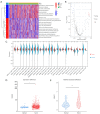Expression and prognostic impact of VDAC3 in colorectal adenocarcinoma
- PMID: 39430839
- PMCID: PMC11483328
- DOI: 10.21037/tcr-24-402
Expression and prognostic impact of VDAC3 in colorectal adenocarcinoma
Abstract
Background: Colorectal adenocarcinoma (COAD) is a malignant tumor with high mortality and low 5-year survival rate. Voltage-dependent anion channel 3 (VDAC3) is the least understood isoform of voltage-dependent anion-selective channels in the mitochondrial outer membrane. In this thesis, we aimed to investigate the prognostic value of VDAC3 and provide new insights into colon adenocarcinoma.
Methods: We utilized The Cancer Genome Atlas (TCGA) database, Gene Expression Omnibus (GEO) database, Human Protein Atlas online database, and the University of ALabama at Birmingham CANcer data analysis Portal (UALCAN) database to analyze VDAC3 expression in COAD and assess patient survival rates. Univariate and multivariate Cox regression analyses were employed to evaluate VDAC3's prognostic significance for COAD. Gene set variation analysis (GSVA) was utilized to explore COAD-related signaling pathways associated with VDAC3. Additionally, we predicted the relationship between VDAC3 expression and anticancer drug sensitivity using the CellMiner database.
Results: In the TCGA database, VDAC3 demonstrated elevated expression levels in COAD, which was further validated by findings from the GEO database. Survival analysis conducted using Kaplan-Meier (K-M) curves highlighted that the patients with decreased VDAC3 expression exhibited significantly shorter overall survival durations. VDAC3 expression demonstrated correlation with COAD pathological stage. VDAC3 gene mutation was linked to COAD outcomes. Cox regression analysis showed that VDAC3 was an independent predictor. In addition, GSVA analysis showed that VDAC3 was closely related to mitochondria-related biological processes and involved in the occurrence and development of mitochondria-related diseases. Finally, analysis of the CellMiner database predicted that VDAC3 expression was positively correlated with chelerythrine and cladribine, but negatively correlated with Ergenyl.
Conclusions: Our study suggests that VDAC3 may be a potential biomarker for early diagnosis, prognosis, and treatment of COAD.
Keywords: Colon adenocarcinoma; biomarker; prognosis; voltage-dependent anion channel 3 (VDAC3).
2024 AME Publishing Company. All rights reserved.
Conflict of interest statement
Conflicts of Interest: All authors have completed the ICMJE uniform disclosure form (available at https://tcr.amegroups.com/article/view/10.21037/tcr-24-402/coif). The authors have no conflicts of interest to declare.
Figures








References
LinkOut - more resources
Full Text Sources
Miscellaneous
